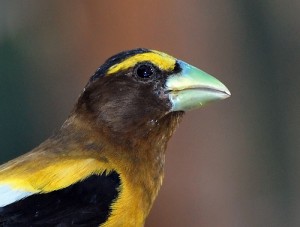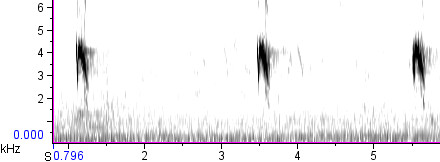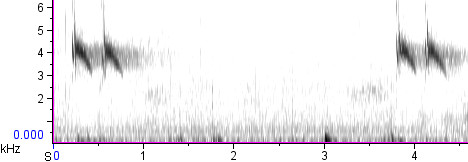Evening Grosbeak Call Types

In 2004, a paper appeared in the Condor by Kendra Sewall, Rodd Kelsey and Tom Hahn that described several different variants of flight calls in the Evening Grosbeak. Their fascinating research immediately reminded many of the work on the call types of Red Crossbill, and I heard a few people worry out loud about whether a split of Evening Grosbeak might be in the works.
But there’s no cause for worry. The “call types” of Evening Grosbeak are not as scary as the call types of Red Crossbill. While Red Crossbills sort into at least 10 call types in North America, Evening Grosbeaks apparently sort into just 5. And while multiple Red Crossbill call types often occur in one area (which is part of the justification for splitting them into separate species), the Evening Grosbeak call types usually stay in fairly well-defined, separate geographic ranges. In fact, Sewall et al. note that the five call type groups seem to match the five subspecies groups in a decades-old taxonomy.
Learning to identify Evening Grosbeak call types is a fascinating exercise, especially if you come upon a wandering flock and want to know where they likely originated. This post aims to provide an introduction to the different “types” and how to tell them apart.
“Flight calls” vs. “Trills”
The terminology used by Sewall et al. (2004) as well as the BNA account of Evening Grosbeak distinguishes two main calls that are typically heard from the species: “flight calls” and “trills.” Neither source mentions how the “trills” may vary among groups; this post is going to concern itself solely with the flight calls, which are the most common vocalizations.
Type 1
Range: The northern Rockies and the Cascades, from at least British Columbia south to Oregon, northern Wyoming, and the Black Hills of South Dakota. Wanders to the northern Sierra Nevada and to Colorado.
Flight call:

Even though the spectrogram shows that it tends to start at a higher frequency than other types, Type 1 sounds relatively low-pitched, especially compared to Types 2 and 4. It has a very clear sound that is distinctive once you learn it. More than the other types, this one reminds me of a particular Pine Siskin call (but beware! Pine Siskins can mimic other Evening Grosbeak types in their songs). Here’s another good recording of Type 1.
Type 2
Range: The Sierra Nevada of California; wanders at least occasionally north to southern Washington.
Flight call:

To my ear, this sounds like the clearest, most purely whistled type, even clearer than Type 1, but it is distinctly higher-pitched and more piercing than Type 1. Type 2 is quite similar to Type 4 and the two may be difficult to distinguish by ear in the field (see below).
Type 3
Range: Boreal forests of Canada east of the Rockies and in the northeastern United States. Wanders south throughout the East.
Flight call:

The distinctive Type 3 differs from Types 1, 2, and 4 by being slightly longer and lower-pitched and distinctly burry. Field guides with an eastern focus have often compared the calls of Evening Grosbeak to certain vocalizations of House Sparrow, and Type 3 is the reason why.
Type 4
Range: The southern Rockies (Colorado and New Mexico), occasionally wandering north at least to the vicinity of Jackson Hole, Wyoming.
Flight call:

The high-pitched and piercing Type 4 flight calls are most similar to Type 2 flight calls, both on the spectrogram and to the ear, but slighty huskier and less clear. I’m not certain I could tell them apart in the field with confidence, but the two have never yet been recorded in each others’ range to my knowledge. Here’s another recording of Type 4.
Type 5
Range: The Sierra Madre of Mexico, north to southeastern Arizona.
Flight call: To my knowledge, only one recording of this type has been made, and here it is:

If this recording is typical, then Type 5 is distinctive: even longer and burrier than Type 3, but high-pitched like Types 2 and 4. If I had to guess, I’d say that the doubled rhythm is probably due to the whim of this individual bird, not characteristic of Type 5 in general, but who knows? — maybe Type 5 is the Mountain Pygmy-Owl of Evening Grosbeaks. If you have any recordings of Evening Grosbeak from Arizona or Mexico (or you know someone who does), please let me know!
Regions of Mystery
There are some places where we don’t really know which type to expect:
- Southwest Oregon and northern California: Types 1 and 2 have both been recorded in this region, and the actual limits of their distribution here are poorly known.
- Black Hills of South Dakota: The one recording I have is of Type 1, but I think Type 3 might also be likely, and Type 4 might wander in.
- Arizona: My guess would be that Type 4 is most common in the northern and central parts of the state, while Type 5 is the most likely type to be encountered in the southeastern mountains, but we need more data.
You know what that means: more recordings necessary!
4 thoughts on “Evening Grosbeak Call Types”
A timely post, and as usual, good stuff. I’ll be heading to BC in another week, and Arizona in another month so will listen for the different types. I’m very familiar with Type 3, but I don’t recall noticing that EVGR in BC sounded much different than Type 3. I will definitely pay closer attention now.
When you’re in Arizona, record any Evening Grosbeaks you find! Same goes for crossbills. Best of luck in the field.
As hinted above, some of the Evening Grosbeak types do overlap, but generally speaking they sort out much better than the Red Crossbill types. Type 2 seem to at least occasionally occur in areas with type 1 and type 1’s have also been found in areas with type 4….and they have been known to nest in the same areas. I also have seen/heard a single recording of an E. Grosbeak from Maryland that might be a type 4 –I have sent the recording to Dr. Hahn and await his analysis.
Type 1 occurs in more southern areas of BC and type 3 occurs across the boreal areas of central to northern BC.
Yes, E. Grosbeak recordings from Arizona are much needed.
Comments are closed.